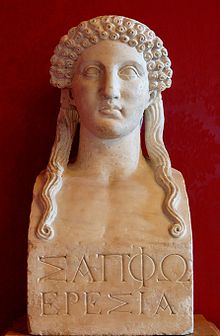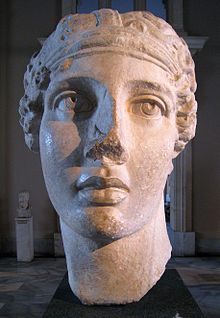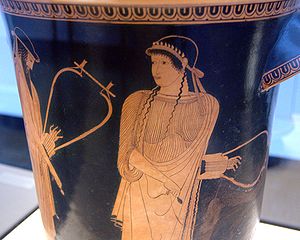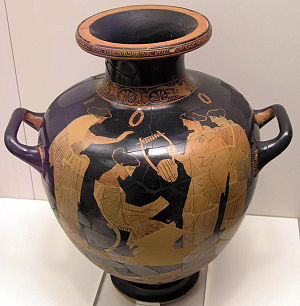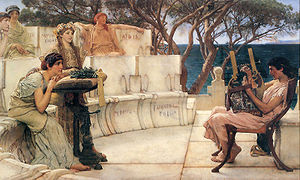- Sappho
-
Sappho (
 /ˈsæfoʊ/; Attic Greek Σαπφώ [sapːʰɔː], Aeolic Greek Ψάπφω [psapːʰɔː]) was an Ancient Greek poet, born on the island of Lesbos. Later Greeks included her in the list of nine lyric poets. Her birth was sometime between 630 and 612 BC, and it is said that she died around 570 BC, but little is known for certain about her life. The bulk of her poetry, which was well-known and greatly admired throughout antiquity, has been lost, but her immense reputation has endured through surviving fragments.
/ˈsæfoʊ/; Attic Greek Σαπφώ [sapːʰɔː], Aeolic Greek Ψάπφω [psapːʰɔː]) was an Ancient Greek poet, born on the island of Lesbos. Later Greeks included her in the list of nine lyric poets. Her birth was sometime between 630 and 612 BC, and it is said that she died around 570 BC, but little is known for certain about her life. The bulk of her poetry, which was well-known and greatly admired throughout antiquity, has been lost, but her immense reputation has endured through surviving fragments.Contents
Life
The only contemporary source for Sappho's life is her own poetry, and scholars are skeptical of reading it biographically. Later biographical accounts are also unreliable.[1]
Chronology
Strabo indicates that Sappho was the contemporary of Alcaeus of Mytilene (born ca. 620 BC) and Pittacus (ca. 645 - 570 BC), and according to Athenaeus, she was the contemporary of Alyattes of Lydia (ca. 610 - 560 BC). The Suda, a 10th century Byzantine encyclopædia, dates her to the 42nd Olympiad (612/608 BC), meaning either that she was born then or that this was her floruit. The versions of Eusebius state that she was famous by the first or second year of the 45th or 46th Olympiad (between 600 and 594 BC). Taken together, these references make it likely that she was born ca. 620 BC, or a little earlier.
Judging from the Parian Marble, she was exiled from Lesbos to Sicily sometime between 604 and 594 BC. If Fragment 98 of her poetry is accepted as biographical evidence and as a reference to her daughter (see below), it may indicate that she had already had a daughter by the time she was exiled. If Fragment 58 is accepted as autobiographical, it indicates that she lived into old age. If her connection to Rhodopis (see below) is accepted as historical, it indicates that she lived into the mid-6th century BC.[2][3]
Family
An Oxyrhynchus papyrus from around AD 200[4] and the Suda agree that Sappho had a mother called Cleïs and a daughter by the same name. The papyrus line reads "She [Sappho] had a daughter Cleis named after her mother." (Duban 1983, 121) Two preserved fragments of Sappho's poetry refer to a Cleïs. In Fragment 98, Sappho addresses Cleïs, saying that she has no way of obtaining a decorated headband for her. Fragment 132 reads in full: "I have a beautiful child [pais] who looks like golden flowers, my darling Cleis, for whom I would not (take) all Lydia or lovely..."[5] These fragments have often been interpreted as referring to Sappho's daughter, or as confirming that Sappho had a daughter with this name. But even if a biographic reading of the verses is accepted, this is not certain. Cleïs is referred to in Fragment 132 with the Greek word pais, which can as easily indicate a slave or any young person as an offspring. It is possible that these verses or others like them were misunderstood by ancient writers, leading to the biographical tradition which has come down to us.[6]
Fragment 102 has its speaker address a "sweet mother", sometimes taken as an indication that Sappho began to write poetry while her mother was still alive.[7] The name of Sappho's father is widely given as Scamandronymus,[8] but he is not referred to in any of the surviving fragments. In his Heroides, Ovid has Sappho lament that, "Six birthdays of mine had passed when the bones of my parent, gathered from the pyre, drank before their time my tears." Ovid may have based this on a poem by Sappho no longer extant.[9]
Sappho was reported to have three brothers: Erigyius (or Eurygius), Larichus and Charaxus. The Oxyrhynchus papyrus indicates that Charaxus was the eldest, but that Sappho was more fond of the young Larichus.[10] According to Athenaeus, Sappho often praised Larichus for pouring wine in the town hall of Mytilene, an office held by boys of the best families.[11] This indication that Sappho was born into an aristocratic family is consistent with the sometimes rarefied environments that her verses record.
A story recorded by Herodotus, and later by Strabo, Athenaeus, Ovid and the Suda, tells of a relation between Charaxus and the Egyptian courtesan Rhodopis. Herodotus, the oldest source of the story, reports that Charaxus ransomed Rhodopis for a large sum and that after he returned to Mitylene, Sappho scolded him in verse.[12] Strabo, writing some 400 years later, adds that Charaxus was trading with Lesbian wine and that Sappho called Rhodopis Doricha. Athenaeus, another 200 years later, calls the courtesan Doricha and maintains that Herodotus had her confused with Rhodopis, another woman altogether.[9] He also cites an epigram by Posidippus (3rd c. BC) that refers to Doricha and Sappho. Based on this story, scholars have speculated that references to a Doricha may have been found in Sappho's poems. None of the extant fragments have this name in full but Fragments 7 and 15 are often restored to include it.[13] Joel Lidov has criticized this restoration, arguing that the Doricha story is not helpful in restoring any fragment by Sappho and that its origins lie in the work of Cratinus or another of Herodotus' comic contemporaries.[14]
The Suda is alone in claiming that Sappho was married to a "very wealthy man called Cercylas, who traded from Andros"[15] and that he was Cleïs' father. This tradition may have been invented by the comic poets as a witticism, as the name of the purported husband means "Penis, from Men's Island."[16]
Exile
Sappho's lifetime witnessed a period of political turbulence on Lesbos and saw the rise of Pittacus. According to the Parian Marble, Sappho was exiled to Sicily sometime between 604 and 594 and Cicero records that a statue of her stood in the town-hall of Syracuse. Unlike the works of her fellow poet, Alcaeus, Sappho's surviving poetry has very few allusions to political conditions. The principal exception is Fragment 98, which mentions exile and indicates that Sappho was lacking some of her customary luxuries. Her political sympathies may have lain with the party of Alcaeus.[17] Though there is no explicit record of this, it is usually assumed that Sappho returned from exile at some point and that she spent most of her life in Lesbos.
Phaon legend
A tradition going back at least to Menander (Fr. 258 K) suggested that Sappho killed herself by jumping off the Leucadian cliffs for love of Phaon, a ferryman. This is regarded as unhistorical by modern scholars, perhaps invented by the comic poets or originating from a misreading of a first-person reference in a non-biographical poem.[18] The legend may have resulted in part from a desire to assert Sappho as heterosexual.[19]
Sexuality and community
Sappho's poetry centers on passion and love for various personages and both genders. The word lesbian derives from the name of the island of her birth, Lesbos, while her name is also the origin of the word sapphic; neither word was applied to female homosexuality until the nineteenth century.[20][21] The narrators of many of her poems speak of infatuations and love (sometimes requited, sometimes not) for various females, but descriptions of physical acts between women are few and subject to debate.[22][23] Whether these poems are meant to be autobiographical is not known, although elements of other parts of Sappho's life do make appearances in her work, and it would be compatible with her style to have these intimate encounters expressed poetically, as well. Her homoerotica should be placed in the context of the seventh century (BC). The poems of Alcaeus and later Pindar record similar romantic bonds between the members of a given circle.[24]
Sappho's contemporary Alcaeus described her thus: "Violet-haired, pure, honey-smiling Sappho" (ἰόπλοκ᾽ ἄγνα μελλιχόμειδε Σάπφοι, fr. 384). The third-century philosopher Maximus of Tyre wrote that Sappho was "small and dark" and that her relationships to her female friends were similar to those of Socrates:
- What else could one call the love of the Lesbian woman than the Socratic art of love? For they seem to me to have practised love after their own fashion, she the love of women, he of men. For they said they loved many, and were captivated by all things beautiful. What Alcibiades and Charmides and Phaedrus were to him, Gyrinna and Atthis and Anactoria were to her ...[25]
During the Victorian era, it became fashionable to describe Sappho as the headmistress of a girls' finishing school. As Page DuBois (among many other experts) points out, this attempt at making Sappho understandable and palatable to the genteel classes of Great Britain was based more on conservative sensibilities than evidence. There are no references to teaching, students, academies, or tutors in any of Sappho's scant collection of surviving works. Burnett follows others, like C. M. Bowra, in suggesting that Sappho's circle was somewhat akin to the Spartan agelai or the religious sacred band, the thiasos, but Burnett nuances her argument by noting that Sappho's circle was distinct from these contemporary examples because "membership in the circle seems to have been voluntary, irregular and to some degree international."[26] The notion that Sappho was in charge of some sort of academy persists nonetheless.
Works
Alexandrian edition of Sappho's poetry
The Library of Alexandria collected Sappho's poetry into nine books, mostly based on their meter:
- Book I, poems composed in the Sapphic stanza, 330 stanzas in all (Fragments 1–42);
- Book II, poems composed in glyconic lines with dactylic expansion (Frr. 43–52);
- Book III, poems in Greater Asclepiad distichs (Frr. 53–57);
- Book IV, poems in distichs of a somewhat similar meter (Frr. 58–91);
- Book V, probably consisting of poems in various three-line stanzas (Frr. 92–101);
- Book VI (contents unknown);
- Book VII (only two surviving lines in the same meter, Fr. 102);
- Book VIII (see Fr. 103);
- Book IX, epithalamia in other meters, including dactylic hexameter (Frr. 104–117).
Not every surviving fragment can be assigned to a book (Frr. 118–213 are unassigned), and other meters are represented in the fragments.
Surviving poetry
 Sappho's recently discovered poem on old age (lines 9–20), assigned to Book IV based on its meter. 3rd cent. BC papyrus (P.Köln XI 429), from an exhibit of the Altes Museum
Sappho's recently discovered poem on old age (lines 9–20), assigned to Book IV based on its meter. 3rd cent. BC papyrus (P.Köln XI 429), from an exhibit of the Altes Museum
The surviving proportion of the nine-volume corpus of poetry read in antiquity is small but still constitutes a poetic corpus of major importance. There is a single complete poem, Fragment 1, the Hymn to Aphrodite,[27] quoted in its entirety as a model of the "polished and exuberant" style of composition by Dionysius of Halicarnassus, with admiration of its consummate artistry:[28]
“ Here the euphonious effect and the grace of the language arise from the coherence and smoothness of the junctures. The words nestle close to one another and are woven together according to certain affinities and natural attractions of the letters. ” Other major fragments include three virtually-complete poems (in the standard numeration, fragments 16, 31, and the recently supplemented 58).
Recent discoveries
The most recent addition to the corpus is a virtually-complete poem on old age (fr. 58). The line-ends were first published in 1922 from an Oxyrhynchus papyrus, no. 1787 (fragment 1: see the third pair of images on this page), but little could be made of them, since the indications of poem-end (placed at the beginnings of the lines) were lost, and scholars could only guess where one poem ended and another began. Most of the rest of the poem has recently (2004) been published from a 3rd century BC papyrus in the Cologne University collection (P.Köln XI 429). The latest reconstruction, by M. L. West, appeared in the Zeitschrift für Papyrologie und Epigraphik 151 (2005), 1-9, and in the Times Literary Supplement on 21 June 2005 (English translation and discussion). The poem refers to the plight of Tithonus, with whom the goddess Eos fell in love and requested he become immortal, but forgot to ensure that he stay forever young. The Greek text has been reproduced with helpful notes for students of the language.[29]
Qualities of Sappho's poetry
David Campbell has briefly summarized some of the most arresting qualities of Sappho's poetry:
Clarity of language and simplicity of thought are everywhere evident in our fragments; wit and rhetoric, so common in English love-poetry and not quite absent from Catullus' love poems, are nowhere to be found. Her images are sharp—the sparrows that draw Aphrodite's chariot, the full moon in a starry sky, the solitary red apple at the tree-top—and she sometimes lingers over them to elaborate them for their own sake. She quotes the direct words of conversations real or imaginary and so gains immediacy. When the subject is the turbulence of her emotions, she displays a cool control in their expression. Above all, her words are chosen for their sheer melody: the skill with which she placed her vowels and consonants, admired by Dionysius of Halicarnassus, is evidenced by almost any stanza; the music to which she sang them has gone, but the spoken sounds may still enchant.[30]
Legacy
Reputation in antiquity
In antiquity, Sappho was commonly regarded as one of the greatest lyric poets.[31] The Milan Papyrus, recovered from a dismantled mummy casing and published in 2001, has revealed the high esteem in which the poet Posidippus of Pella, an important composer of epigrams (3rd century BC), held Sappho's "divine songs."[32]
An epigram in the Anthologia Palatina (9.506) ascribed to Plato states:
- Some say the Muses are nine: how careless!
- Look, there's Sappho too, from Lesbos, the tenth.
Claudius Aelianus wrote in Miscellany (Ποικίλη ἱστορία) that Plato called Sappho wise. A story is recounted in the Florilegium (3.29.58) of Stobaeus:
Solon of Athens heard his nephew sing a song of Sappho's over the wine and, since he liked the song so much, he asked the boy to teach it to him. When someone asked him why, he said, "So that I may learn it, then die."
A few centuries later, Horace wrote in his Odes that Sappho's lyrics are worthy of sacred admiration. One of Sappho's poems (fragment 31) was famously translated by the 1st century BC Roman poet Catullus in his "Ille mi par esse deo videtur" ("He seems to me to be equal to a god") (Catullus 51).
Loss and preservation of Sappho's works
Although Sappho's work endured well into Roman times, with changing interests, styles, and aesthetics her work was copied less and less, especially after the academies stopped requiring her study. Part of the reason for her disappearance from the standard canon was the predominance of Attic and Homeric Greek as the languages required to be studied. Sappho's Aeolic Greek dialect is a difficult one, and by Roman times it was arcane and ancient as well, posed considerable obstacles to her continued popularity. Still, the greatest poets and thinkers of ancient Rome continued to emulate her or compare other writers to her, and it is through these comparisons and descriptions that we have received much of her extant poetry.
Once the major academies of the Byzantine Empire dropped her works from their standard curricula, very few copies of her works were made by scribes, and the 12th century Byzantine scholar Tzetzes speaks of her works as lost.[33]
Modern legends, with origins that are difficult to trace, describe Sappho's literary legacy as being the victim of purposeful obliteration by scandalized church leaders, often by means of book-burning.[34] There is no known historical evidence for these accounts.[34] Indeed, Gregory of Nazianzus, who along with Pope Gregory VII, features as the villain in many of these stories, was a reader and admirer of Sappho's poetry. For example, modern scholars have noted the echoes of Sappho fr. 2 in his poem On Human Nature, which copies from Sappho the quasi-sacred grove (alsos), the wind-shaken branches, and the striking word for "deep sleep" (kōma).[35]
It appears likely that Sappho's poetry was largely lost through action of the same indiscriminate forces of cultural change that have left us such paltry remains of all nine canonical Greek lyric poets, of whom only Pindar (whose works alone survive in a manuscript tradition) and Bacchylides (our knowledge of whom we owe to a single dramatic papyrus find) have fared much better.
Sources of the surviving fragments
Although the manuscript tradition broke off, some of Sappho's poetry has been discovered in Egyptian papyri fragments from an earlier period, such as those found in the ancient rubbish heaps of Oxyrhynchus, where a major find brought many new but tattered verses to light, providing a major new source.[36] One substantial fragment is preserved on a potsherd. The rest of what we know of Sappho comes through citations in other ancient writers, often made to illustrate grammar, vocabulary, or meter.
Modern translations
From the time of the European Renaissance, the interest in Sappho's writing has grown. Since few people are able to understand ancient languages, each age has translated Sappho in its own idiomatic way. Poetry, such as Sappho's, written in quantitative verse, is difficult to reproduce in English which uses stress-based meters and rhyme compared to Ancient Greek's solely length-based meters. As a result, many early translators used rhyme and worked Sappho's ideas into English poetic forms. Still, the Sapphic stanza, strongly associated with Sappho's poetry in the original, has become well known and influential among modern poets as well.
In 1904 Canadian poet Bliss Carman published Sappho: One Hundred Lyrics, which was not just a translation of the fragments but an imaginative reconstruction of the lost poems. While of little to no scholarly value, Carman's translations brought Sappho's work to the attention of a wide readership. [37]
In the 1960s, Mary Barnard reintroduced Sappho to the reading public with a new approach to translation that eschewed the use of rhyming stanzas and traditional forms. Subsequent translators have tended to work in a similar manner. In 2002, classicist and poet Anne Carson produced If Not, Winter, an exhaustive translation of Sappho's fragments. Her line-by-line translations, complete with brackets where the ancient papyrus sources break off, are meant to capture both the original's lyricism and its present fragmentary nature. Translations of Sappho have also been produced by Willis Barnstone, Jim Powell, and Stanley Lombardo.
See also
- Ancient Greek literature
- Papyrus Oxyrhynchus 7 - fragment of Sappho's poem
Notes
- ^ See, for example, J. Fairweather, "Fiction in the biographies of ancient writers," Ancient Society 5 (1974); Mary R. Lefkowitz, The lives of the Greek poets, Johns Hopkins UP, 1981.
- ^ (Campbell 1982, p. x-xi)
- ^ Page, Sappho and Alcaeus, p. 224-5.
- ^ P. Oxy. 1800 fr. 1
- ^ (Campbell 1982)
- ^ See e.g. Gordon, pp. xii-xiii
- ^ Robinson, p. 15.
- ^ Herodotus and Claudius Aelianus have Scamandronymus. P. Oxy. 1800 fr. 1 has Scamander or Scamandronymus. The Suda offers a plethora of possibilities: Simon, Eumenus, Eerigyius, Ecrytus, Semus, Camon, Etarchus or Scamandronymus.
- ^ a b (Campbell 1982, p. 15)
- ^ (Campbell 1982, p. 3)
- ^ (Campbell 1982, p. xi & 189)
- ^ (Campbell 1982, p. 187)
- ^ (Campbell 1982, p. 63 & 65)
- ^ Lidov, p. 203 and throughout.
- ^ (Campbell 1982, p. 5)
- ^ Holt Parker, "Sappho Schoolmistress" (orig. pub. Transactions of the American Philological Association 123 (1993), pp. 309-51.
- ^ Page, Sappho and Alcaeus, p. 225-6.
- ^ Lidov, p. 205-6.
- ^ For example, in Reading Sappho: Contemporary Approaches, ed. Ellen Greene, University of California Press, 1996: Mary Lefkowitz, "Critical Stereotypes and the Poetry of Sappho," pp. 28f. (the story of Sappho's death represents her as "deprived because of her ugliness of male attention...which she craves"); Judith Hallett, "Sappho and Her Social Context: Sense and Sensuality," pp. 126f., while sounding a note of caution about careless assumptions of Sappho's homosexuality, discusses the story of Sappho's sexual conversion and death in the context of "disbelief and disapproval" regarding accounts of her homosexuality, which such legends may aim to disprove; Eva Stehle, "Sappho's Gaze: Fantasies of a Goddess and Young Man," p. 195 n. 10, considers that "The story probably developed in fourth-century comedy."
- ^ Douglas Harper (2001). "Lesbian". Online Etymology Dictionary. http://www.etymonline.com/index.php?term=lesbian. Retrieved 2009-02-07.
- ^ Douglas Harper (2001). "Sapphic". Online Etymology Dictionary. http://www.etymonline.com/index.php?term=Sapphic. Retrieved 2009-02-07.
- ^ Denys Page, Sappho and Alcaeus, Oxford UP, 1959, pp. 142-146.
- ^ (Campbell 1982, p. xi-xii)
- ^ Anne Pippin Burnett, Three Archaic Poets: Archilochus, Alcaeus, Sappho, Harvard UP, 1983.
- ^ Campbell 1982, p. 21
- ^ Burnett, Three Archaic Poets, p. 210
- ^ Hymn to Aphrodite, translation, and notes
- ^ De compositione verborum 23, trans. W. Rhys Roberts, Loeb Classical Library, 1910.
- ^ "AOIDOI.org: Epic, Archaic and Classical Greek Poetry". http://www.aoidoi.org/. Retrieved October 30, 2005.
- ^ D.A. Campbell, Greek lyric poetry: a selection of early Greek lyric, elegiac and iambic poetry, 1967, p. 262.
- ^ (Campbell 1982, pp. 37–51)
- ^ English translation of the new epigrams, with notes: "Diotima". http://www.stoa.org/diotima/anthology/epigrams.shtml. Retrieved October 30, 2005.. Greek text: "Center for Hellenic Studies - Epigrams". http://www.chs.harvard.edu/publications.sec/classics.ssp/issue_i_posidippus.pg/epigrams.pg. Retrieved October 30, 2005.
- ^ (Campbell 1982, pp. 50–51)
- ^ a b Reynolds (2002) 81
- ^ Quintino Cataudella, "Saffo fr. 5 (5) – 6 (5) Diehl," Atene e Roma ser. 3 vol. 8 (1940), pp. 199-201. Cf. Page, Sappho and Alcaeus, p. 37.
- ^ An example from book 2 of the collected edition: "Virtual Exhibition". http://www.papyrology.ox.ac.uk/POxy/VExhibition/finds/sappho.html. Retrieved October 30, 2005.
- ^ Charles G.D. Roberts, "The Poetry of Sappho", introduction to Bliss Carman, Sappho: One Hundred Lyrics, Canadian Poetry, UWO. Web, Mar. 24, 2011.
References
- Barnard, Mary (transl.), Sappho: A New Translation, University of California Press; Reissue edition (June 1986) ISBN 0-520-22312-8
- Campbell, D. A. (ed.) (1982). Greek Lyric 1: Sappho and Alcaeus (Loeb Classical Library No. 142). Harvard University Press, Cambridge, Mass.. ISBN 0-674-99157-5 Contains complete Greek text of all poems and fragments (except for some very fragmentary papyri), plus all testimonia (references to Sappho by ancient authors), that were known as of the book's publication date, with literal English prose translations. Probably the single most convenient primary text of Sappho for both English and Greek readers.
- Carson, Anne (transl.), If Not, Winter: Fragments of Sappho, Knopf (2002) ISBN 0-375-41067-8; also Virago Press Ltd, UK, ISBN 1-84408-081-1 (A modern bilingual edition for general readers as well as students of ancient Greek languages; N.Y. Times review)
- DuBois, Page, Sappho Is Burning, University of Chicago Press (1995) ISBN 0-226-16755-0
- Lidov, Joel, "Sappho, Herodotus and the Hetaira", in Classical Philology, July 2002, pp. 203–237.
- Lobel, E. and D. L. Page (eds.), Poetarum Lesbiorum fragmenta, Oxford, Clarendon Press, (1955).
- Page, D. L., Sappho and Alcaeus, Oxford, Clarendon Press, (1955).
- Reynolds, M. The Sappho Companion, New York, Palgrave (2002).
External links
- Texts and translations
- The Divine Sappho (Greek texts and several translations, with essays and criticism)
- aoidoi.org (Greek texts with commentary by William Annis)
- The Poems of Sappho, trans. E.M. Cox (1925 translation with Greek text and transliteration)
- The sound of Sappho? (MP3 audio of five fragments in Greek)
- Greek and Roman love poetry, BBC Radio 4, In Our Time, 26 April 2007
- SORGLL: Sappho 1; read by Stephen Daitz
- Sappho and the World of Lesbian Poetry, by William Harris, Prof. Em. of Classics, Middlebury College
- Reading Sappho, by Ellen Greene, UC Press
Nine Lyric Poets · Ancient Greek Literature Categories:- 7th-century BC births
- 570 BC deaths
- 7th-century BC women
- 6th-century BC Greek people
- 6th-century BC poets
- 6th-century BC women
- 6th-century BC women writers
- Aeolic Greek poets
- Ancient Eresians
- Ancient Greek erotic poets
- Ancient Greek women writers
- Ancient Lesbian poets
- Muses
- Nine lyric poets
- People from Lesbos
- Women poets
Wikimedia Foundation. 2010.

